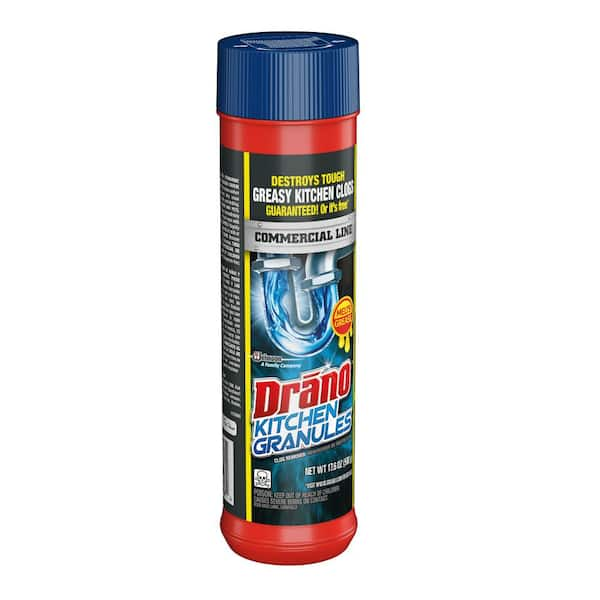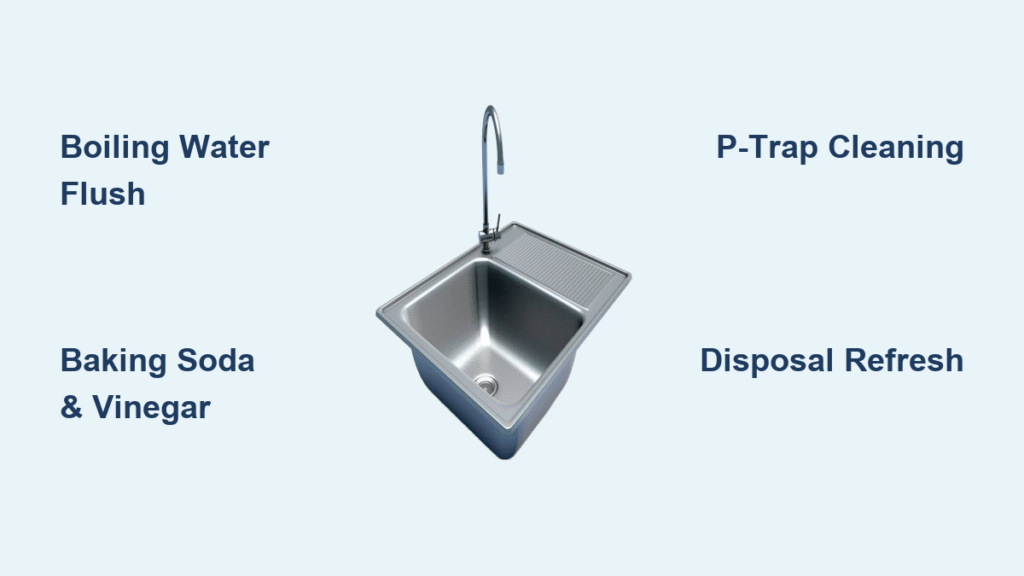That sour milk or rotten-egg stench bubbling up from your kitchen sink isn’t just embarrassing—it’s a red flag your drain is choking on trapped food waste. When grease coats your pipes and bacteria feast on yesterday’s dinner scraps, volatile sulfur compounds turn your sink into a stink factory. The good news? Most odors vanish in under 30 minutes using pantry staples like baking soda and vinegar. This guide delivers battle-tested fixes—from the 5-minute boiling-water trick to P-trap deep cleaning—so you can eliminate odors permanently without calling a plumber.
You’ll learn to diagnose whether sewer gas, decomposing debris, or mold is to blame, then match the solution to your specific problem. No more guessing whether to pour vinegar or call a pro—every step is designed for immediate action with tools you already own. By the time you finish this guide, you’ll have a sink that smells fresh even after grinding up fish bones or avocado pits.
Match Your Odor to the Exact Culprit
Rotten-Egg vs. Sour-Food: Spot the Source in 60 Seconds
Rotten-egg smells mean sewer gas is sneaking past your P-trap’s water seal—often from evaporation during vacations or a cracked pipe joint. Sour-food odors signal decomposing debris trapped in biofilm (that black slime coating your pipes). Musty basement smells point to mold growing in overflow channels or under sink strainers.
Run cold water for 10 seconds: If the stench intensifies, the problem is inside your drain. If it fades, sewer gas is bypassing your P-trap. Shine a flashlight down the drain—black slime on pipe walls confirms organic buildup. Check under the sink: Water pooling beneath the P-trap means a leak, while bone-dry pipes indicate evaporation.
Critical Visual Checks Before You Pour Anything
- Remove the strainer and sniff it—if it reeks, gunk is trapped in the shallow basket.
- Inspect the disposal splash guard for melted plastic (a burnt-motor smell means electrical issues).
- Press your palm over the drain for 10 seconds—cold, damp air means sewer gas infiltration.
Never skip this step: Applying vinegar to a dry P-trap won’t fix sewer gas and wastes your effort.
Banish Odors in 5 Minutes With Pantry Staples
Boiling Water Flush: The Instant Grease Melter
Perfect for: Sour-food smells after cooking with oils or dairy.
1. Boil 2 quarts of water (let cool 1 minute for PVC pipes to avoid softening).
2. Pour in three stages: One-third down the drain, pause 5 seconds, repeat twice.
3. Blast cold tap water for 30 seconds to solidify loosened grease and push it out.
Pro tip: For disposals, grind 2 cups of ice cubes before pouring water—this knocks debris off impellers first.
Baking Soda & Vinegar Volcano: Biofilm Destroyer
Works best for: Chronic sour or musty odors from bacterial slime.
– Dry your sink bowl so baking soda sticks to pipe walls.
– Dump ½ cup baking soda straight into the drain.
– Add 1 cup white vinegar and slap a bowl over the opening to force fizz downward.
– Wait 15–30 minutes (longer for severe odors), then flush with hot water.
Boost results by adding ½ cup coarse salt for scrubbing action and 5 drops tea-tree oil to kill microbes. Skip this if you smell rotten eggs—this won’t fix sewer gas.
Ice & Lemon Cubes: Disposal-Specific Refresh
For disposal units only: Freeze vinegar or lemon juice in trays with thin lemon wedges. Run 3–4 cubes through the disposal with cold water. The ice scrapes debris off impellers while acid dissolves residue. Finish by grinding fresh citrus peels for 5 seconds—this leaves a clean scent and prevents future buildup.
Deep Clean Your P-Trap Without Leaks
Tools That Prevent Flooded Cabinets

Gather a 2-gallon bucket, channel-lock pliers, bottle brush, and enzymatic cleaner. Place the bucket directly under the U-shaped pipe—any misstep here guarantees a mess.
Step-by-Step Trap Cleaning in 10 Minutes
1. Loosen slip nuts by hand first to avoid cracking PVC.
2. Turn nuts a quarter-turn with pliers—water will drain into the bucket.
3. Scrape out black tarry coating with a bottle brush (wear gloves!).
4. Rinse the trap under another sink until water runs clear.
5. Reinstall hand-tight, then tighten only an eighth-turn more. Over-tightening cracks nuts.
Critical check: Run water for 60 seconds while watching joints. If drips appear, tighten minimally until they stop—never force it.
Disposal Deep Clean: Weekly Routine That Prevents Stink
:max_bytes(150000):strip_icc()/How-to-Clean-a-Garbage-Disposal-Refined-Final-098ce78e1bff4f60b95057129a30c09f.jpg)
The 3-Step Weekly Cycle
- Flush: Run hot water + 2 tsp degreasing dish soap for 30 seconds.
- Grind: Toss 2 cups ice + ¼ cup kosher salt into the disposal for 10 seconds.
- Freshen: Grind citrus peels for 5 seconds to leave a clean scent.
Monthly Overhaul: Stop Mold in Overflow Channels
- Unplug the disposal (or flip the breaker).
- Remove the rubber splash guard and scrub both sides with baking-soda paste.
- Shine a flashlight upward—use a long brush to dislodge stringy fibers wrapped around the flywheel. This hidden gunk causes 70% of disposal odors.
Commercial Cleaners: When Pantry Fixes Fail

Pick the Right Product for Your Smell Type
| Smell Type | Product | Critical Safety Note |
|---|---|---|
| Grease-heavy | Drano Kitchen Granules | Wait 15 minutes max—never mix with vinegar! |
| Biofilm slime | Enzymatic cleaner (Green Gobbler) | Leave overnight; safe for septic systems |
| Moldy | 1:10 bleach solution | Use only after vinegar flushes; never mix with ammonia |
Never combine chemicals: Bleach + vinegar creates toxic chlorine gas. Always flush with hot water between applications.
Prevent Future Stink With 30-Second Daily Habits
Your Odor-Proofing Routine
- After every use: Run hot water for 10 seconds to melt residual grease.
- Daily: Scrape plates into compost—never let coffee grounds or eggshells enter the drain.
- Weekly: Sprinkle 2 tbsp baking soda down the drain, rinse with hot water.
Vacation Trick That Stops Sewer Gas
Pour ½ cup mineral oil into the drain before leaving—it floats on the P-trap water, slowing evaporation for months. This prevents the #1 cause of rotten-egg smells during trips.
Quarterly Deep Maintenance
Remove pop-up stoppers and soak them in vinegar for 15 minutes. Inspect P-trap connections for hairline cracks—replace washers if water pools under the sink.
Call a Plumber Only When These 4 Signs Appear
Stop DIY efforts immediately if:
– Rotten-egg odor persists after refilling a dry P-trap (indicates vent stack blockage).
– Multiple drains smell simultaneously (signals main sewer line trouble).
– Water backs up into the sink when the dishwasher runs (danger of sewage overflow).
– Gurgling sounds occur in other fixtures when you flush toilets (vent system failure).
These require professional drain cameras or roof-vent inspections—don’t waste time on baking soda when your main line is collapsing.
Final Note: Most kitchen sink odors vanish with the boiling-water flush or baking soda-vinegar combo—no special tools needed. Bookmark this guide under your sink: when stink strikes, match your odor to the culprit, then apply the corresponding fix. Within 30 minutes, you’ll have a fresh-smelling sink that handles even greasy spaghetti nights. For ongoing success, commit to the 10-second hot-water rinse after every dish—this simple habit prevents 90% of future odors. If sewer gas lingers after P-trap checks, call a plumber immediately; that rotten-egg smell means dangerous methane is entering your home.



